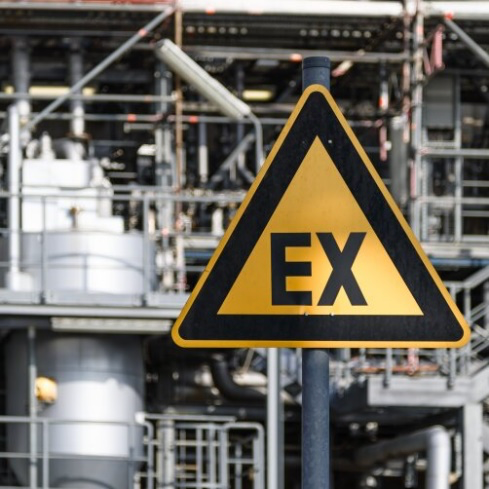Pre-Compliance Review Services
Let F2 Labs assist you in determining the best approach for obtaining approvals. Once determined, we can review your product against the appropriate standards and provide you with specific guidance on the changes that would need to be made before the product could be certified.
EU-Type Test Approvals
At F2 Labs, we work directly with the ATEX Notified Body and they will accept the evaluation and testing that we conduct.
We are also able to conduct most, if not all, of the required testing at our facilities. For unique tests that are outside of our scope, we are able to seamlessly coordinate these tests with laboratories in our network here in the United States in the United Kingdom.
With our working arrangements with these test labs, you will not need to wait in a queue. Your project will be put in their schedule immediately
ATEX Directive 2014/34/EU Testing
ATEX Directive 2014/34/EU, formerly 94/9/EC
ATEX 2014/34/EU concerns equipment and protective systems intended for use in potentially Explosive Atmospheres.
Before a manufacturer places equipment that could be used in an explosive atmosphere on the market, they must have their product tested to the appropriate standards under the ATEX 2014/34/EU directive. The product must be CE marked.
F2 Labs’ knowledgeable staff can assist manufacturers in determining the appropriate CE and ATEX standards for electrical and non-electrical equipment. Get your product to market with our expertise in ATEX testing and certification.
F2 Labs can perform the testing, Intrinsic Safety (IS) certification evaluations you need in order to reach your intended market.
ATEX Directive Testing – F2 Labs can assist you in meeting the requirements of the ATEX Directive 2014/34/EU for products intended to be used in potentially explosive atmospheres.
ATEX Classifications:
| Ex Zone Definitions | |
|---|---|
| Gas, Mists, or Vapors | Dusts |
| **Note: Zones are classified by the frequency and likeliness of substances being present during the normal operation of the product. | |
|
|
Get a quick, personalized ATEX compliance quote today:
The ATEX 2014/34/EU Directive identifies two groups of equipment:
- Group 1 – ‘equipment-group I’ means equipment intended for use in underground parts of mines, and in those parts of surface installations of such mines, liable to be endangered by firedamp and/or combustible dust, comprising equipment categories M 1 and M 2 as set out in Annex I
- Group 2 – ‘equipment-group II’ means equipment intended for use in other places liable to be endangered by explosive atmospheres, comprising equipment categories 1, 2, and 3 as set out in Annex I
ATEX Standards:
EN 1127 – Explosive atmospheres – Explosion prevention and protection – Part 1: Basic concepts and methodology
Explosive atmospheres – Explosion prevention and protection – Part 2: Basic concepts and methodology for mining
Equipment and components intended for use in potentially explosive atmospheres in
underground mines
Industrial Trucks – Safety requirements and verification – Supplementary requirements for operation in potentially explosive atmospheres
Reciprocating internal combustion engines -Safety requirements for design and
construction of engines for use in potentially explosive atmospheres – Part 1: Group II engines for use
in flammable gas and vapour atmospheres
Reciprocating internal combustion engines – Safety requirements for design and construction of engines for use in potentially explosive atmospheres – Part 2: Group I engines for use
in underground workings susceptible to firedamp and/or combustible dust
Reciprocating internal combustion engines – Safety requirements for design and
construction of engines for use in potentially explosive atmospheres – Part 3: Group II engines for use in flammable dust atmospheres
Atomising and spraying equipment for coating materials – Safety requirements
Non-electrical equipment for use in potentially explosive atmospheres – Part 1: Basic
method and requirements
Non-electrical equipment for use in potentially explosive atmospheres – Part 2:
Protection by flow restricting enclosure “fr”
Non-electrical equipment for use in potentially explosive atmospheres – Part 3:
Protection by flameproof enclosure “d”
Non-electrical equipment intended for use in potentially explosive atmospheres – Part 5: Protection by constructional safety “c”
Non-electrical equipment for use in potentially explosive atmospheres – Part 6:
Protection by control of ignition source “b”
Non-electrical equipment for potentially explosive atmospheres – Part 8: Protection by
liquid immersion “k”
LPG equipment and accessories – Construction and performance of LPG equipment for
automotive filling stations – Part 1: Dispensers
Conveyor belts for use in underground installations – Electrical and flammability safety requirements
Design of fans working in potentially explosive atmospheres
Explosive atmospheres – Part 36: Nonelectrical equipment for explosive
atmospheres – Basic method and requirements (ISO 80079-36:2016)
Explosive atmospheres – Part 37: Nonelectrical equipment for explosive
atmospheres – Non-electrical type of protection constructional safety “c” control of ignition sources “b” liquid immersion “k” (ISO 80079-37:2016)
Quality System Assessment
As an additional requirement, the ATEX Directive requires a Quality Audit for ATEX EU-Type Test Certified products. This audit is similar to an ISO9001 audit. However, it contains some ATEX specific requirements (outlined in EN80079-34).
Most agencies need to bring auditors from overseas to conduct these audits. However, with F2 Labs, there is no need to fly someone over from Europe. This can be done by our staff here in the United States.
